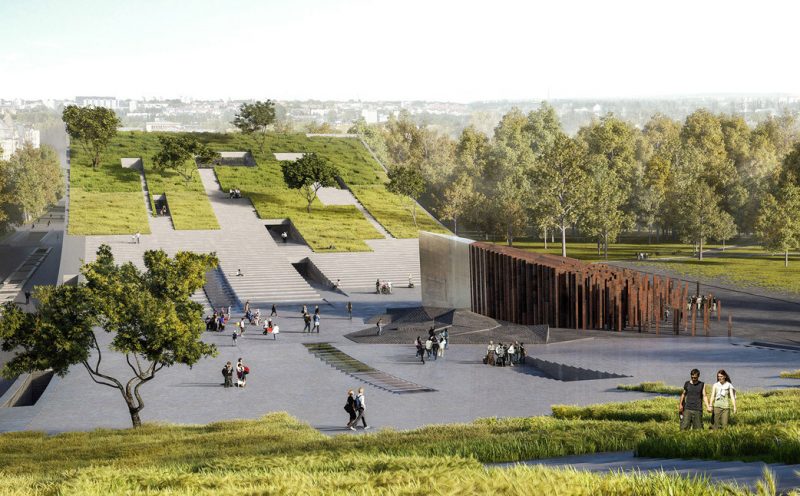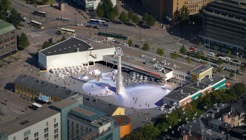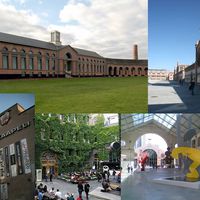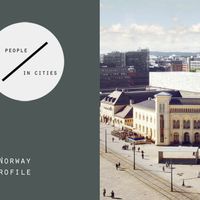What future for museums in Europe?
 ASEF culture360 contributor Florent Petit explores the current boom of museums throughout Europe and tries to analyse the trends beneath some of the major projects scheduled for the years to come.
ASEF culture360 contributor Florent Petit explores the current boom of museums throughout Europe and tries to analyse the trends beneath some of the major projects scheduled for the years to come.[caption id="attachment_61531" align="aligncenter" width="431"]
 National Museum Zurich Source : https://www.nationalmuseum.ch/e/[/caption]
National Museum Zurich Source : https://www.nationalmuseum.ch/e/[/caption]Despite the current economic issues with the recent Euro and debt crisis, and major cuts made in public funding related to cultural activities, the present European art scene is marked by an impressive number of opening or reopening of museums across the continent, showing the vitality of these institutions.
2016 has been indeed marked by the inauguration of new wings in the Tate Modern in London, in the Kunstmuseum in Basel, in the Swiss national museum building in Zürich and the brand new, National Museum built in Tartu, Estonia. Among the noticeable museum openings this year, we can also mention the Museum Voorlinden in Wassenar in the Netherlands, resulting from a private initiative, or the MAAT (Museum of Art, Architecture and Technology) in Lisbon, funded by the Foundation EDP (EDP being the electricity company in Portugal). This impressive complex, set by the Tagus River, is composed of a renovated early 20th century power station and a new cutting edge building together forming one of the most important and visited cultural complex in the whole country.
[caption id="attachment_61527" align="aligncenter" width="442"]
 Estonian National Museum - Tartu
Estonian National Museum - Tartusource : http://www.erm.ee/en[/caption]
Besides, the end of this November will be marked by the inauguration of the Design Museum in London in its new precincts, the renovated former Commonwealth headquarters building near Holland Park.
How can this continuing blooming of museums, visible now in Europe for several decades can be explained? Why are so many Europeans cities and towns thriving to possess a unique cultural structure that will let them become a bright spot on the European cultural map?
An impressive number of renovation projects
The years to come will, without a doubt, be marked by numerous renovations of existing institutions. This is a logical path for some institutions with a long history who feel the need to plan extensive renovation to give a new dimension and dynamic to their activities.
In Scandinavia for instance, the reopening of the National Museum in Stockholm is planned for the year 2018, when the works currently going on in the historic building located on Blasieholmen will be completed. The aim of the renovation is to raise the museum to contemporary and eco-friendly standards, to better display the artworks and ensure better visiting conditions for the viewers.
In neighbouring Denmark, a similar renovation is led in order to provide the capital city of Copenhagen with a new Natural History Museum, planned to open in 2021, consisting of a relocation on one site, (a 19th century building set in the botanical garden) of all zoological and geological collections in the hands of the University of Copenhagen. This will turn the museum into one of the most prominent European institution to deal with natural history.
Union makes strength (or all in one)
[caption id="attachment_61533" align="aligncenter" width="437"]
 Plateforme10 - Lausanne
Plateforme10 - LausanneSource: http://www.plateforme10.ch/fr[/caption]
Some other projects show an even more ambitious context and also rely, along the cultural project, on the will to give the city the opportunity to cast urban environment regeneration projects for entire zones. This is currently what is at stake with the future museums hub projects under construction in Lausanne (Switzerland), Oslo (Norway) and Budapest (Hungary).
Bearing in mind the gathering of several world class institutions in one specific area, like the Museuminsel in Berlin, the Museumplein in Amsterdam, or the Museums quartier in Wien, the three cities mentioned above have launched gigantic cultural projects based on the relocation of several museums in one specific area (Budapest) or purposed-built building (Lausanne and Oslo), to create important multipurpose centres where a vast cultural offer will be proposed in just one place, allowing access to very different kinds of collections, and, at the same time, providing a new impulse for entire urban areas.
Plateforme10 – Lausanne
The plateforme10 project in Lausanne is currently under construction near the central railway station, in a key location in the city, on a ground that belonged to the Swiss national railway company. The architectural project will give the opportunity to rejuvenate the whole district around the train station. The idea is to relocate in this place up to 5 different museums, including the Museum of Fine Arts of Lausanne and the renowned Elysée Museum of photography.
Nasjonalmuseet - Oslo
In Oslo, Norway, the purpose of the future National Museum is to provide the Norwegian capital with a new “all arts” museum that will unite in one place several institutions (National Gallery, Museum of contemporary Art, National Museum of Architecture and Museum of Decorative Art and Design), currently scattered across the city. The new building sheltering these structures will open in 2020. The interesting thing in this project, beside the fact of marking a new step in the history of the national collections of Norway, is that it bears several similarities with the project developed simultaneously in Lausanne. The plan is to settle the new complex that will occupy an entire block near the old Vestbanen train station, in the very heart of Oslo, at a stone’s throw from the waterfront and iconic City Hall building.
One of the decisive aspects here is to create an important art hub in the very heart of the city, with excellent transportation connection with the rest of the city and beyond.
[caption id="attachment_61529" align="aligncenter" width="400"]
 Nasjonalmuseet - Oslo Source: http://www.nasjonalmuseet.no/en/the_national_museum/the_new_national_museum/[/caption]
Nasjonalmuseet - Oslo Source: http://www.nasjonalmuseet.no/en/the_national_museum/the_new_national_museum/[/caption]Liget Budapest
Another noticeable project currently developed in Central Europe is the Liget Budapest Project in Hungary. The aim is to redevelop in the green lung of the Hungarian capital a renewed and amplified museum quarter: the Varosliget Park is currently the home of the Museum of Fine Arts, (closed for renovation). Just in front of it across Heroes’ square, lies the Mucsarnok (Kunsthalle), one of the most renowned structures for contemporary art in the region. This museum hub will unfold in two steps, with the reopening of the Museum of Fine Arts in mid-2018, the completion of a National Museum Restoration and Storage Centre, and the restoration of the Museum of Science, Technology and Transport. This will also bring back to the building lying on the north edge of the city park, its pre-World War II condition and its original splendour. The second mile stone of the project is to provide the park with 3 new buildings designed to welcome new museums delivered in 2019: a new National Gallery to showcase Hungarian and International art from early 19th century to the present day, designed by Japanese architecture firm SANAA; a brand new House of Hungarian Music, designed by Japanese architect Sou Fujimoto with the Cité de la Musique in Paris and the Haus der Musik in Vienna as its models. The last building to be completed, lying on the South-western corner of the city park, will be the new Museum of Ethnography, created by Hungarian firm Napur Architect.
What is striking with these 3 examples is the ambition and efforts shown by the 3 cities to cast the local museum scene in 21st century, creating a somehow brutal rupture with the past.
[caption id="attachment_61539" align="aligncenter" width="620"]
 Museum of Ethnography Budapest Source: http://www.intezmenyek.ligetbudapest.eu/en/places/future/museum-of-ethnography[/caption]
Museum of Ethnography Budapest Source: http://www.intezmenyek.ligetbudapest.eu/en/places/future/museum-of-ethnography[/caption]Is buying a brand the only way to shine?
The year was 1997. The Guggenheim Foundation was opening the new iconic museum designed by American architect Franck Gehry that quickly turned the city of Bilbao in Spain into an international tourist destination. This was the first developing model that is still having success nowadays. On the other hand, we should ask ourselves how far can this process of duplication go? It does not seem to discourage the development plans of some European cities that still value that franchising model. Helsinki, the capital of Finland, has concluded an agreement with the Guggenheim Foundation in order to open a new museum on the waterfront, near the old market hall. This would be the 5th city in the world, and the 3rd in Europe with Bilbao and Venice, to get its Guggenheim. Despite the firm opposition of a fringe of the local political scene to the project, mostly for economic reasons (the estimated cost is around 130 million euros), the project goes on and looks at building the new Guggenheim within 5 years.
This idea of creating a branch of an internationally renowned museum in another city abroad is far from being isolated. By the end of 2020, Barcelona will have its own Hermitage museum in a purpose-built precinct by the harbour (the second of the famous museum outside Russia with its branch in Amsterdam). After Malaga in Spain, the famous Centre Pompidou in Paris will open a new branch in Brussels that will unfold in a former garage, jewel of Art Deco architecture, which has already cost 20 million euros to the capital region of Brussels for the sole acquisition of the building. At the same time, the modern and contemporary art collections of the Royal Museums of Fine Arts of Belgium are still waiting to find a home within Brussels to be displayed. On the other hand, the Centre Pompidou is looking even further with 2 projects currently developed in Shanghai (China) and Seoul (Korea).
There seem to be no limits for some of the biggest and most famous museums in the world: they hold extensive collections but are eager to expand and capture new audiences in the process (earning a substantial financial gain at the same time).
[caption id="attachment_61528" align="aligncenter" width="410"]
 Guggenheim Helsinki Source: http://designguggenheimhelsinki.org/en/finalists/winner[/caption]
Guggenheim Helsinki Source: http://designguggenheimhelsinki.org/en/finalists/winner[/caption]Before these museum projects were announced, Brussels, Amsterdam, Barcelona and Helsinki were already important cultural hubs that could have been followed as examples of development. However, there seem to be no limit to the desire of cultural, tourist (and economic?) development in Europe.
Can these museums be considered and treated as an international brand with showrooms scattered in the most important global cities around the world? It would be perhaps risky to complain that museums appear as dynamic institutions and it would surely not be a valid option to claim there can be too much cultural offer in a city. Nonetheless, it would be reasonable to question what are the limits of this model? Can this ever-expanding museum become a commodity that can be bought like any other product on a shelf?
[caption id="attachment_61526" align="aligncenter" width="374"]
 New Natural History Museum - Copenhagen Source: http://snm.ku.dk/english/[/caption]
New Natural History Museum - Copenhagen Source: http://snm.ku.dk/english/[/caption]Other places in Europe are showing an alternative way: a longer, certainly more difficult (but not less pricey) path, creating their proper ecosystem and network of cultural structures with their own means, forces and will. Let’s go back to Stockholm. When it deals with contemporary art for instance, the Swedish capital can now count on such remarkable structures as Artipelag, Bonniers Konsthall, Fotografiska, Marabouparken, Magasin III, Lilevachs or Färgfabriken that are placing it at the centre of the contemporary creativity in Scandinavia and Europe.
The museum scene in Europe is a perpetually moving landscape, with multiple projects launched across the continent. But some of them look more like a pretext to promote the city as a global destination instead of a tool to improve the offer and engagement of local communities.
This expansion of big museum brands is happening not only in other countries but also within the national borders.
Intake for example the opening in 2012 of the new Louvre Museum in the French town of Lens; the equally famous Victoria and Albert Museum, one of the most prominent museums in the world when it deals with design and fashion, will launch the V&A Museum of Design in the Scottish town of Dundee in 2018. It will be built by famous Japanese architect Kengo Kuma, and will be part of a wider £1 billion project of regeneration of the Dundee waterfront, showing once more, if that was still needed, that most of this cultural projects are often included in wider environmental and urban renewal projects, and will definitely tag museums as an essential component of the development of cities in Europe in the last 20 years.
[caption id="attachment_61532" align="aligncenter" width="350"]
 Amos Andersen Art Museum - Helsinki Source: http://amosanderson.fi/en/lasipalatsi/[/caption]
Amos Andersen Art Museum - Helsinki Source: http://amosanderson.fi/en/lasipalatsi/[/caption]It seems now that, for those who can afford it, hosting a temporary exhibition is not enough. When some of the most prestigious institutions in the world have a collection that can fill entire buildings, it is now almost natural for them to search for another home abroad matching the expectations of several cities to shine bright on the cultural map.
In a very urban continent like Europe, where tourism has become an industry creating a harsh competition between cities to draw visitors, it is essential for cities to project an attractive image. There is a global competition going on, pressing cities to possess their own cultural gem, no matter how much it will cost. This phenomenon is certainly not exclusive to Europe but is probably best seen at present on this continent. 20 years after the opening of the Guggenheim Museum in Bilbao, the wish to get a similar success still fuels several local and regional governments, beside the fact that less visible, networking initiatives of smaller structures also allow cities to get a rich cultural ecosystem that can become attractive for foreign audiences.
Are these initiatives able to create a rich and vibrant cultural scene or are they just meant to attract tourists? To what extend can this model continue to be replicated?
This article is only dealing with museums set in major urban centres, making no mention of those settled in smaller urban areas. For these smaller cities, funding is much smaller although they are still in need to serve local communities.
These projects show how some “want it all and want it now”. The only thing they cannot afford (or want to afford) is the time needed to develop or consolidate a sustainable network of cultural institutions relying on local initiatives that would in the long-term help build the city’s reputation.
[caption id="attachment_61530" align="aligncenter" width="386"]
![Museum Voorlinden, Wassenaar [image: Pietro Savorelli] Source : www.voorlinden.nl](https://culture360.asef.org/wp-content/blogs.dir/1/files/2016/11/Voorlinden.jpg) Museum Voorlinden, Wassenaar
Museum Voorlinden, Wassenaar[image: Pietro Savorelli] Source : www.voorlinden.nl[/caption]
Let’s look at Helsinki again. While the Guggenheim Museum project and its ups and downs are getting international attention, not many outside Finland know that the Amos Anderson Art Museum (funded more than 70 years ago and holding one of the most remarkable and noteworthy modern art collection in all Scandinavia), will move in 2018 to its new premises. Wouldn’t this be a better way to stimulate the vitality of the local museum scene?
Web links
- DENMARK
Natural History Museum of Denmark – Copenhagen: http://snm.ku.dk/english/ - ESTONIA
Estonian National Museum – Tartu: http://www.erm.ee/en - FINLAND
Amos Anderson Art Museum – Helsinki: http://amosanderson.fi/en/
Guggenheim Helsinki: http://designguggenheimhelsinki.org/en/ - HUNGARY
Liget Budapest: http://www.ligetbudapest.org/eng/ - NETHERLANDS
Museum Voorlinden – Wassenar: http://www.voorlinden.nl/?lang=en - NORWAY
National Museum - Oslo: http://www.nasjonalmuseet.no/en/ - PORTUGAL
Museum Art Architecture Technology MAAT - Lisbon: https://www.maat.pt/en - SWEDEN
National Museum – Stockholm: http://www.nationalmuseum.se/Artipelag – Stockholm: http://artipelag.se/
Bonnierskonsthall – Stockholm: http://www.bonnierskonsthall.se/en/
Fotografiska – Stockholm: http://fotografiska.eu/
Marabouparken – Stockholm: http://marabouparken.se/
Magasin III – Stockholm: https://www.magasin3.com/
Liljevalchs – Stockholm: http://www.liljevalchs.se/
Färgfabriken – Stockholm: http://www.fargfabriken.se/sv/ - SWITZERLAND
Kunstmuseum - Basel: http://www.kunstmuseumbasel.ch/en/home/
Plateforme10 – Lausanne: http://www.plateforme10.ch/fr
National Museum Switzerland - Zurich: https://www.nationalmuseum.ch/e/ - UNITED KINGDOM
Tate Modern - London: http://www.tate.org.uk/visit/tate-modern
Design Museum – London: http://designmuseum.org/
Florent PETIT is a former project officer in the cultural unit of the French Embassy in Japan. He holds a Master’s degree in Art History from the Sorbonne University in Paris and in International Relations from the Institute of Political Studies of Lyon. Former lecturer of Chinese, Korean and Japanese art in the Ecole du Louvre in Paris, he has occupied several curatorial positions in museums in France (Asian Unit of the Musée du quai Branly, Paris) and Luxembourg (Mudam, Museum of contemporary art, Luxembourg City).





